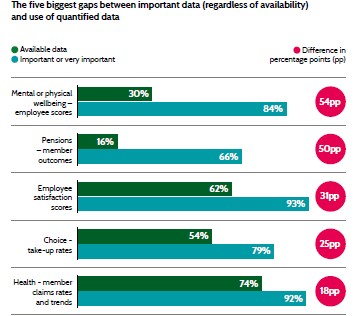In-depth analysis holds the key to accurately interpreting benefits data
Employers value quantified data, yet format, analysis and access to data tools mean that challenges in accurately interpreting benefits data persist.
Evidencing costs, budgets and forecasting is therefore crucial for senior leadership reporting.
The research showed that most employers are using data to discern benefits costs, budgets and forecasting, while employee scores for mental and physical wellbeing are also readily available.
However, the findings showed that fewer employers have access to more detailed information about their benefits, such as health claims rates and trends, employee pension contributions or absence levels.
Given a dearth of more detailed data, many employers could be relying on high-level information, such as annual benefits costs and basic usage figures, to report on benefits performance, rather than being able to undertake more in-depth analysis of their benefits offering.
Benefits data is often available, but it is the quality and ability to interpret data from one or many sources that can act as a barrier to gaining more useful insights.

For some benefits, there is a way to go before the gap between value and availability is met. However, it is encouraging that employers are aware of the value and importance that benefits data can bring when seeking approval or reporting on benefits performance.
For more on this topic, download REBA's Benefits Design Research 2025, in partnership with Howden Employee Benefits.







